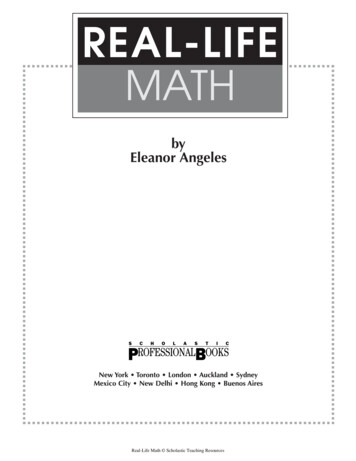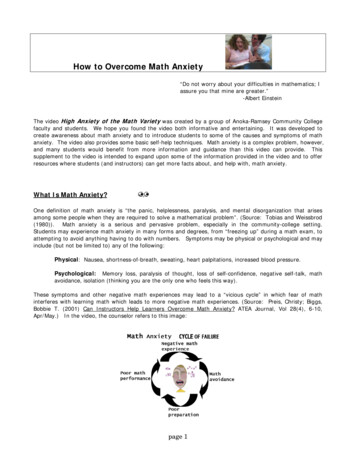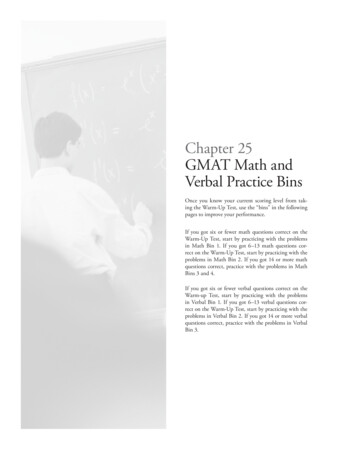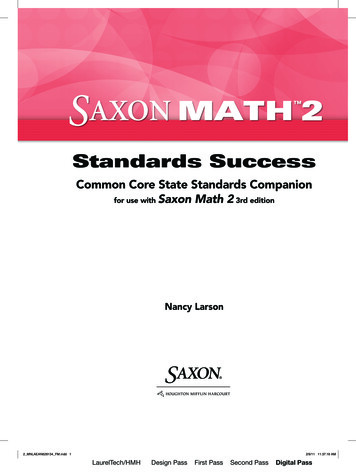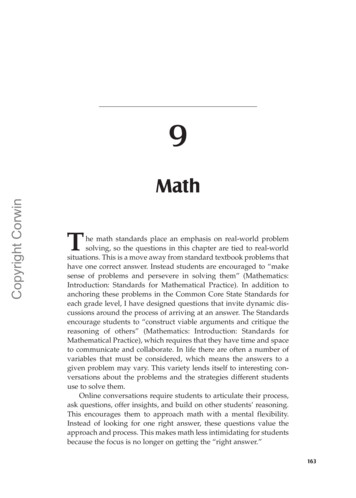
Transcription
9Copyright CorwinMathThe math standards place an emphasis on real-world problemsolving, so the questions in this chapter are tied to real-worldsituations. This is a move away from standard textbook problems thathave one correct answer. Instead students are encouraged to “makesense of problems and persevere in solving them” (Mathematics:Introduction: Standards for Mathematical Practice). In addition toanchoring these problems in the Common Core State Standards foreach grade level, I have designed questions that invite dynamic discussions around the process of arriving at an answer. The Standardsencourage students to “construct viable arguments and critique thereasoning of others” (Mathematics: Introduction: Standards forMathematical Practice), which requires that they have time and spaceto communicate and collaborate. In life there are often a number ofvariables that must be considered, which means the answers to agiven problem may vary. This variety lends itself to interesting conversations about the problems and the strategies different studentsuse to solve them.Online conversations require students to articulate their process,ask questions, offer insights, and build on other students’ reasoning.This encourages them to approach math with a mental flexibility.Instead of looking for one right answer, these questions value theapproach and process. This makes math less intimidating for studentsbecause the focus is no longer on getting the “right answer.”163
164Blended Learning in Grades 4–12I have also incorporated elements of both argument and informative writing into these questions to encourage writing across the curriculum. Judy Willis (2011), former neurologist and teacher, asserts,Copyright CorwinWhen learning is examined through shared writing, studentsare exposed to multiple approaches to solving problems. Thisis so important in building the flexibility and open-mindedapproach. . . . Furthermore, students have the chance to communicate using their own words. They build communicationskills they will surely use in their collaborations now and inthe future science and math communities they will enter.(para. 9)Dr. Willis highlights the importance of writing to support thebrain’s ability to take in, process, and retain concepts. She asserts thatwriting “can increase [students’] comfort with and success inunderstanding complex material, unfamiliar concepts, and subjectspecific vocabulary” (para. 3). Since work done in online discussionsmust take the written form, this encourages students to explain theirapproach to math in writing, therefore fortifying their understandingof mathematical concepts.Common Core State Standards:Upper Elementary MathThe following are the math standards addressed for the upperelementary level. I have also listed the Grades 4–5 writing standardsbecause online work requires that students articulate their ideas inwriting and publish them online.Grades 4–5 Math Standards Addressed4.NF.4Apply and extend previous understandings of multiplicationto multiply a fraction by a whole number. . . . Solve wordproblems involving multiplication of a fraction by a wholenumber, e.g., by using visual fraction models and equations torepresent the problem.5.G.2Represent real-world and mathematical problems by graphingpoints in the first quadrant of the coordinate plane, andinterpret coordinate values of points in the context of thesituation.
CHAPTER 9 MathGrades 4–5 Writing Standards AddressedW.4-5.4Produce clear and coherent writing in which the developmentand organization are appropriate to task, purpose, andaudience.W.4-5.6With some guidance and support from adults, use technology,including the Internet, to produce and publish writing as wellas to interact and collaborate with others.Copyright CorwinNote: The language describing each standard is taken directly from the Common Core StateStandards Initiative website: www.corestandards.org.In fourth and fifth grade, the Standards state that students shouldfocus on operations, algebraic thinking, fractions, measurements, andgeometry. Though these questions focus on specific mathematicalconcepts, the question ideas can be applied to a variety of topics.Example Online Activity 9.1. How WouldGraphing Points on a Coordinate PlaneHelp Solve Real-World Problems?Common Core Standards5.G (Geometry)The coordinate plane feels static and far removed from “real life,”so this question challenges students to select a real-life circumstanceand show how a coordinate plane can be used to problem solve.Students are able to choose a situation—astronomy, land use planning, or art—to think about in relation to the coordinate plane. Byhaving several different topics to choose from, students can focustheir energy on figuring out how the coordinate plane would be usedin this situation. They must think about how charting points on agraph might be helpful to solving a problem in a given field. To dothis, they have to consider how a chart would allow an astronomer,land use planner, or artist see relationships between points on thecoordinate plane.Weave Online Work Into the ClassroomWith Student-Centered Activities1. Career Research. As a class, brainstorm careers that use graphing ona regular basis. Once the class has generated a list, put students in165
Blended Learning in Grades 4–12Copyright Corwin166small groups and assign a career to each group. Each career groupresearches how graphing is used in the job they are studying. What education is required for this job? What type of math must a person learn to work in thisoccupation?
167CHAPTER 9 Math When would a person in this profession need to create and/orread graphs? Explain how graphs make their work easier or more successful.This activity can be extended if each group creates a Lino canvasonline (for more on Lino, see p. 126) where they post informationabout the career they researched. This can help students who areinterested in math find out more about occupations that require math.Copyright Corwin2. Brainstorming. In groups,ask students to think aboutgraphs they have seen outsidethe classroom.Wall Wisherwww.wallwisher.comCreate a multimedia wall where students can What kinds of graphsbrainstorm ideas, post notes, and attach files,do you see every day?pictures, music, and video. What information doFreethey provide? How is the graph display of informationmore helpful than if that information was written out?Be prepared to share the highlights of your discussion with theclass. This brainstorm can take place in class or online using WallWisher.3. Creative Graphing Assign National Center for Educationment. Ask students to graphStatistics Kids’ Zonetheir home or school on acoordi nate plane. Tell to label the important pointsCreate kid-friendly graphs (XY, bar, line, area, oron the graph that representpie).key places, rooms, andobjects in their home or atFreeschool. Make sure they useall four quadrants of thecoordinate plane. Include an artistic component by asking them todraw small symbols or pictures to represent locations (e.g., bed torepresent a bedroom at home, slice of pizza to symbolize thecafeteria at school). Students can also use the Kids’ Zone graphcreator available on the National Center for Education Statisticswebsite.
168Blended Learning in Grades 4–12Copyright CorwinExample Online Activity 9.2.Design a Word Problem: MultiplyingFractions to Solve Real-World Problems
CHAPTER 9 Math169Copyright CorwinCommon Core Standards4.NF (Number and Opera tions—Khan AcademyFractions)This activity provides awww.khanacademy.orgKhan Academy video embedAccess thousands of videos on a variety of topded into the discussion topicics, including math, science, astronomy, art histo support students’ undertory, and test preparation. Students can alsostanding of fractions. Khancomplete practice questions.Academy is a nonprofit eduFreecation site with thousands ofvideos on a variety of academic topics. The videos areshort tutorials led by Salman Khan, who explains concepts in a clear,easy-to-understand style. These videos can help support studentswhen they are working at home and struggling with a concept. Ihighly recommend embedding the videos into discussion topics todifferentiate instruction and engage students in conversations aboutthe topics discussed in the tutorials.Once students have watched the Khan video (once, twice, threetimes depending on how much support they need), they must thinkabout how they use fractions in their own lives and create a real-lifeproblem involving fractions for their peers to solve. This activity can beapplied to a variety of mathematical concepts. Because it requires thatstudents apply the concept to their own lives, the teacher is freed fromhaving to design a collection of real-life scenarios involving fractions. Italso challenges students to consider carefully the problem and how theypresent that problem in writing so that it is clear and easy to understand.Once students have posted their word problems, other studentsare able to critique any that are unclear or missing information. Thisis an incentive for students to take care designing and writing wordproblems that others can answer. Students must attempt to solve atleast one of their peers’ word problems and explain their process.This requires that they not only design an original problem but alsopractice solving one and explain in writing how they got their answer.Weave Online Work Into the Classroom WithStudent-Centered Activities1. Group Strategy Session. Have students share their best tips and/orstrategies for solving word problems using their peers’ word problems
170Blended Learning in Grades 4–12Google Docsdocs.google.comCreate a shared Google doc for collaboration, oruse Google forms to design a survey and collectinformation.Free (gmail account needed)as examples. Once they haveshared tips, they can practicewriting more complex wordproblems that require anadditional step to solve. Theclass can add their tips andstrategies to a shared Googledoc, which they can add tothroughout the year, creatinga student-generated studyguide.Copyright CorwinTeacher’s Note: Study Guides and Strategies is an education publicservice website that has a page titled “Solving Math Word Problems”:www.studygs.net/mathproblems.htm.2. Word Problem Challenge. Ingroups, ask students to writeanother word problem aboutwww.educreations.comfractions (or a related topic)Create and share video lessons in minutes. Theand exchange with anotheriPad app is an interactive whiteboard thatgroup. Students work to getherrecords what students say and write. Imagesto solve the problem, thencan also be uploaded into the virtual lesson.present the solution with aclear explanation to the classFreeusing a whiteboard or pro jector. If iPads are available,students could actually record their own student-produced videos,similar to Khan Academy tutorials, using Educreations.Educreations3. Fraction Fun With ComicStrips. In small groups, askstudents to draw a comicwww.readwritethink.org/files/resources/strip representation of a wordinteractives/comic/index.htmlproblem based on a real-lifeCreate cartoons and comics with images andscenario, with each squarethought bubbles to share or print.focused on a step in the wordproblem. Encourage studentsFreeto be creative with thecharacters, insert humor, andhave fun with this! Studentscan use the online comic creator available from ReadWriteThink ordesign a comic Pixton (for more on Pixton, see p. 105).ReadWriteThink
CHAPTER 9 MathCommon Core State Standards:Middle School MathThe following are the math standards addressed for middle school. Ihave also listed the Grades 6–8 writing standards because onlinework requires that students articulate their ideas in writing andpublish them online.Copyright CorwinGrades 6–8 Math Standards Addressed6.RP.1Understand the concept of a ratio and use ratio language todescribe a ratio relationship between two quantities.7.SP.1Understand that statistics can be used to gain informationabout a population by examining a sample of the population;generalizations about a population from a sample are validonly if the sample is representative of that population.Understand that random sampling tends to producerepresentative samples and support valid inferences.7.SP.2Use data from a random sample to draw inferences about apopulation with an unknown characteristic of interest.Generate multiple samples (or simulated samples) of the samesize to gauge the variation in estimates or predictions.Grades 6–8 Writing Standards AddressedW.6-8.4Produce clear and coherent writing in which the developmentand organization are appropriate to task, purpose, andaudience.W.6-8.6With some guidance and support from adults, use technology,including the Internet, to produce and publish writing as wellas to interact and collaborate with others.Note: The language describing each standard is taken directly from the Common Core StateStandards Initiative website: www.corestandards.org.In sixth and seventh grades, the standards focus on ratios, proportions, the number system, expressions, equations, geometry, statistics,and probability. In eighth grade students also learn about functions. Thescope of their study in each area develops each year to include more171
172Blended Learning in Grades 4–12complex concepts and build on work done the previous year. As such theactivities I designed for this section can be simplified for younger students (sixth) or made more complex for older students (eighth).Copyright CorwinExample Online Activity 9.3.Design a Survey, Take a Random Sampling,and Make a Generalization
173CHAPTER 9 MathCopyright CorwinCommon Core StandardsSurveyMonkey7.SP.1, 7.SP.2, W.6-8.4, W.6-8.6www.surveymonkey.comThis activity asks students to do a variety of differQuickly create a survey, get feedback, and anaent tasks to develop theirlyze the results.understanding of statisticsFreeand probability. First, theymust design a survey about atopic of interest to them; theycan do this on paper or online. SurveyMonkey can be used to createand provide access to an online survey. Second, they must considerwhat a random sampling is and how it can be achieved. Third, theymust collect survey responses and use the results to make some generalizations about the larger population.Teachers immediately grab student interest when they ask students to design a survey on a topic of their choice; this creates immediate buy-in from students. With a class full of survey topics, results,and generalizations, this activity paves the way for countless followup discussions and debate opportunities.Weave Online Work Into the ClassroomWith Student-Centered Activities1. Survey the Class. Have students survey the entire class using thesurvey they designed for homework. Once everyone has taken thesurveys, give students time to analyze the results. Have studentsdiscuss these questions in small groups: What were the results of the survey in class compared to theresults of your previous random sampling? How did the opinions of your classmates differ from those ofyour random sampling? Were the generalizations you made based on your randomsampling representative of the results you got from theclass? How do you think the age of a population you survey impactsthe results?2. Debate. Ask students to debate the following questions: Is there such a thing as a truly random sampling? If so, how canthis be achieved? If not, what barriers exist that are impossibleto overcome?
174Blended Learning in Grades 4–12 What factors impact the truthfulness of a survey? Under what conditions might a person you are surveying givea dishonest or inaccurate answer? How can this possible inaccuracy be eliminated or reduced?3. Evaluating Trends in the U.S.Census. Divide the class intosmall groups, and providecreately.comthem with the results of theCreate and collaborate on diagrams online.2000 and 2010 U.S. Censuses.Drag and drop shapes, insert text, and useAsk the groups to identifyarrows to connect ideas. Share or export.key pieces of data to compareand analyze. What generali Create five free diagrams.zations, patterns, and trendsdo they observe? What mightbe the importance of thesepatterns and trends? Students can chart the trends they observe usingCreately, an online graph maker.Copyright CorwinCreatelyTeacher’s Note: The U.S. Census Bureau (www.census.gov) has postedthe census information for both 2000 and 2010.Example Online Activity 9.4. Real-Life RatiosCommon Core Standards6.RP.1, W.6-8.4, W.6-8.6In sixth grade students must “understand ratio concepts and useratio reasoning to solve problems” (Mathematics: Grade 6: Ratios andProportional Relationships), then in seventh grade they must begin to“analyze proportional relationships” (Mathematics: Grade 7: Ratios andProportional Relationships). To effectively move from understanding toanalyzing proportional relationships, it is helpful to begin by asking students to discuss how they “see” and understand ratio relationships intheir lives. That way they can begin to brainstorm real ratios theyencounter and think about problems involving ratios in their lives.I used the vote or suggest question structure in CollaborizeClassroom to allow students to vote for their favorite example. Thisprovides an incentive for students to be creative in their choices andcarefully write their answers to ensure they are clear. If you are usinga learning platform or learning management system without a votingfeature, this activity can be done manually by asking students toselect their favorite to share in class.
Copyright CorwinCHAPTER 9 MathWeave Online Work Into the ClassroomWith Student-Centered Activities1. Observing Ratios in Life. Divide the class into groups, and give eachgroup a picture of a real-life situation. Students then brainstorm asmany ratios as they can about the people and/or objects in the phototo share with the class. This could be facilitated as a timed game withgroups competing to identify the most ratios in a given amount oftime.175
176Blended Learning in Grades 4–12Teacher’s Note: Google hosts the Life magazine photo archive, whichhas millions of historic photos teachers can use for this activity:images.google.com/hosted/life.Copyright Corwin2. Ratios in Cooking. Ask students what meals or snacks they prepareat home. What ratios do they use? Have them write a recipe usingratios. This activity can culminate in a demonstration/presentation inwhich students prepare this dish in front of the class, explaining theratios involved, or record a video of preparing this dish at home. Thisactivity encourages students to make the connection between ratiosand measurements. Students can post these recipes with photos onPen.io (for more on Pen.io, see p. 128).3. Ratios in the Classroom. Clear space in the classroom so students cancomfortably move around and place a line down the center of theroom. Then ask them to split based on gender, hair color, height,favorite sports, and so on. After each movement, ask them to observethe ratios in the room. Follow this activity with a discussion in smallgroups or a reflective writing assignment. What trends did the students notice? What generalizations can they make about the larger schoolpopulation based on this activity? What did they realize about their classmates?Common Core State Standards:High School MathThe following are the math standards addressed for high school. Ihave also listed the Grades 9–12 writing standards because onlinework requires that students articulate their ideas in writing andpublish them online.Grades 9–12 Math Standards AddressedA-CED.1Create equations and inequalities in one variable and usethem to solve problems.A-RED.1Explain each step in solving a simple equation as followingfrom the equality of numbers asserted at the previous step,starting from the assumption that the original equation hasa solution. Construct a viable argument to justify a solutionmethod.
CHAPTER 9 MathS-IC.1Understand statistics as a process for making inferencesabout population parameters based on a random samplefrom that population.S-MD.5Weigh the possible outcomes of a decision by assigningprobabilities to payoff values and finding expected values.Copyright CorwinGrades 9–12 Writing Standards AddressedW.9-12.4Produce clear and coherent writing in which thedevelopment and organization are appropriate to task,purpose, and audience.W.9-12.6Use technology, including the Internet, to produce, publish,and update individual or shared writing products, takingadvantage of technology’s capacity to link to otherinformation and to display information flexibly anddynamically.Note: The language describing each standard is taken directly from the Common Core StateStandards Initiative website: www.corestandards.org.The standards for high school are listed in categories by concept:number and quantity, algebra, functions, modeling, geometry, statistics, and probability. These mathematical concepts span multiplecourses in Grades 9–12 and vary in complexity depending on thegrade level.Example Online Activity 9.5. Which Is MoreDangerous—Men’s Rugby or Women’s Cheerleading?Common Core StandardsS-IC.1, S-MD.5, W.9-12.4, W.9-12.6This question requires students to use math modeling to link“classroom mathematics and statistics with everyday life, work, anddecision-making” (Mathematics: High School: Modeling: Introduction).To answer the question students have to decide on the mathematical process and statistical information needed to solve thisproblem.Real-world events and problems “are not organized and labeledfor analysis; formulating tractable models . . . and analyzing them isappropriately a creative process” (Mathematics: High School:177
Blended Learning in Grades 4–12Copyright Corwin178Modeling: Introduction). This creative element requires that studentsask questions, conduct research to locate necessary data, identify significant variables, and consider a variety of approaches to problemsolving. In addition to using mathematical modeling to answer the
CHAPTER 9 Mathquestion, students must clearly report “on the conclusions and reasoning behind them” in writing (Mathematics: High School: Modeling:Introduction). Because they must select the sport they believe is mostdangerous and justify their answer with evidence and analysis, thisalso has an element of argument writing.Weave Online Work Into the ClassroomWith Student-Centered ActivitiesCopyright Corwin1. Group Discussion. Divide the class into small groups to discuss thefollowing questions: What strategies do you use when you come across a problemyou cannot solve? How do you cope with not having enough information to solvea problem? How can learning to deal with problems that seem impossiblehelp you solve difficult word problems? Why is it crucial to have strategies to solve problems whendealing with real-life situations?Once they have had a conversation about these questions, askstudents to create a helpful tips poster with their strategies for problemsolving that they can post in the classroom. This can also be done onlinewith a creative tool like Glogster (for more on Glogster, see p. 93).2. Group Challenge. In small groups, students write a word problembased on a real-life situation with a piece of missing information andthen exchange with another group. The groups work together tosolve the problem despite the missing piece of information. After theyhave attempted to solve their problem, they explain their processwith the class.3. Creative Assignment. Divide the class into small groups, and presentthem with a real-life problem to be solved (e.g., designing the layoutof the booths for Club Awareness Day, creating an emergency plan forthe school to evacuate quickly and effectively during a fire, analyzingthe possible risks to students on campus). Ask them to show theirprocess using a flowchart with images to represent the problem,variables, relationship between variables, operations, results, andconclusions. They then present this visual to the class and explainhow they solved the problem. Students can also create an onlineflowchart using Gliffy (for more on Gliffy, see p. 111).179
180Blended Learning in Grades 4–12Copyright CorwinExample Online Activity 9.6. Algebra: How Much IsCollege Going to Cost You?
CHAPTER 9 MathCopyright CorwinCommon Core StandardsA-CED.1, A-RED.1, W.9-12.4, W.9-12.6The rising cost of college is a hot topic in education, and it is asubject of interest to many students considering postsecondary studies. This question presents students with a multistep problem. Tosolve the problem and answer the question, they must apply theirunderstanding of algebra.First, students must select a college to research. They need to findout the yearly tuition for that school and then factor in the rate atwhich the tuition is increasing on average each year. They must alsofind out how much time the average undergraduate spends at thatschool before earning his or her degree.Once students have done this preliminary research, they have toresearch college loans and determine how long it would take to payoff their loan if they attended this school for X (number of years) atan annual rate of Y (cost of tuition per year) factoring in Z (the rate ofincrease in tuition per year). Then they take that number and determine how long it would take to pay off a standard student loan forthe cost of their college degree.For many students not only does this question deal with a topicthey care about, but the information they find during their researchwill be important to consider as they progress in school.Weave Online Work Into the ClassroomWith Student-Centered Activities1. Class Discussion. In small groups, ask students to discuss thefollowing questions and then be prepared to discuss as a whole class: Were you surprised by the cost of tuition? Do you think the cost of college is worth the benefits? What are the benefits of attending a 4-year college oruniversity?This could also be extended into another research assignment anddiscussion.Teacher’s Note: The Pew Research Center, a nonpartisan fact tank,released a report in May 2011 titled “Is College Worth It?” This wouldmake an interesting addition to the discussion of college, the costsassociated with earning a degree, and the benefits of having a degreein today’s job market. A summary of the report is available at181
182Blended Learning in Grades ducation-system.Copyright Corwin2. Cutting College Costs. Ask students to research their “safety school”to see if it is a better deal than the school they initially researched.Have them compare the two schools and brainstorm ways they couldcut costs. What is the price of housing? Is there an alternative place tolive near the campus that would be cheaper? What does a meal plancost? Could you work part time? If so, what would you do for work,how many hours could you reasonably work a week, and whatwould a realistic income be? How could saving money or earningmoney help you manage the cost of college without incurring hugedebt? Ask students to present their findings in small groups.3. Interest Rates Activity. Have students graph how much money theywould owe if they paid off their student loan in 5, 10, 15, or 20 years.(Note: Students should use the total cost of college they calculatedfrom the online activity.) Their graphs should visually show thedifference in total costs for each year marker. Ask them to considerthe following questions: How much would your payments change if you paid off yourstudent loan earlier? How much money could you save if you paid off your loan in10 years versus 20 years? What did this exercise teach you about interest?Students should be prepared to share their charts with the class.Students can create their charts using Gliffy (for more on Gliffy, seep. 111) or Creately (for more on Creately, see p. 174).Chapter SummaryThe math standards identify key areas of focus per grade level fromkindergarten through eighth grade. Each year the math conceptsbuild on the work done the previous year. Mathematical conceptsbecome increasingly complex as students move through school.Because students move from a general to a more specific under standing of these ideas, it is critical that they have a solid foundationon which to build. Providing students with a space to discuss,describe, analyze, question, collaborate, and problem solve makes itpossible for them to understand challenging mathematical concepts.
Copyright CorwinCHAPTER 9 MathThe high school standards identify key conceptual categories ofstudy that students need in order to be prepared for life beyond highschool: number and quantity, algebra, functions, modeling, geometry,statistics, and probability. These areas of study span multiple coursesand build on the foundation created in Grades K–8.Incorporating online discussions and group work into the traditional math curriculum takes math from solitary practice to collaborative effort. Students have a support network of peers they can talkwith about problems they encounter. It also makes it easier for teachers to present students with real-life scenarios and problems that theyneed to solve. This need to make tangible connections between mathconcepts and real life is stressed throughout the Standards.In this chapter I have designed two online math problems withreal-life relevance for each level: upper elementary, middle school,and high school. These activities engage students in problem solvingand collaboration. They include media to grab student interest andmake abstract concepts more concrete. These activities can be madesimpler or more complex depending on your student population.Book Study Questions1. How do you make math relevant for your s
Fraction Fun With Comic Strips. In small groups, ask students to draw a comic strip representation of a word problem based on a real-life scenario, with each square focused on a step in the word problem. Encourage students to be creative with the c






